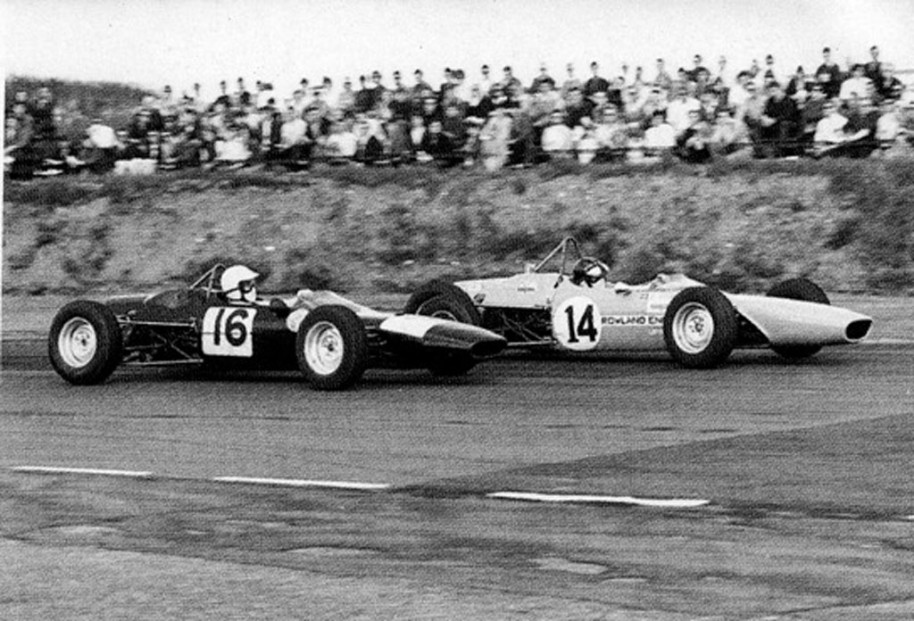Thanks to John Wilson for sending through these wonderful recollections of his time racing with Emerson Fittipaldi. Take a few minutes, and enjoy his story!
Thanks to John Wilson
Flicking through the latest Motor Sport and reaching the tribute to Emerson Fittipaldi, I nearly fell off the chair to see the photo of Emmo and me in dicing Merlyns at Snetterton in 1969 – how many lifetimes ago was that race!
I guess I shouldn’t have been surprised, because that was the day a major talent announced its arrival in Europe. The story of the race was recounted in Emerson’s biography, where he couldn’t remember who the other driver was.
Well, I remember, because it was me.
A couple of years earlier and unknown to my parents back in Australia, I had cashed in my return fare to go motor racing in England. I served an apprenticeship driving an E type Jaguar in the mod sports series, which was pretty exciting and very competitive with people like Pearce, Quick, Cowin, Schroeder and Lewis banging wheels, but Formula Ford arrived and the top drivers like Tim Schenken had leapt to stardom from the class.
If you were seriously ambitious in the late sixties, Formula Ford was the way to join the queue to a F1 berth, so gathering every penny I had, plus a few I hadn’t, I managed to fund myself into a Merlyn Mk11A.
The little Merlin was like a toy after the brutality of the E types, which in those days still had lots of rubber in their suspensions and didn’t necessarily go where they were pointed and I soon discovered that although the Formula Fords were supposed to have identical power plants, to make sure that every driver had the same chance, the reality was quite different.
There are not two engines ever built that put out exactly the same power, and the factory drivers always get the best in any formula. A couple of extra horsepower in a featherweight chassis makes one big difference. Formula Ford specs mandated standard road car camshaft timing, strangely however, there were some very rorty sounds coming from some of the engines in the paddock and there were some cars that pulled relentlessly away from you on a clear straight. Very odd that.
Unlike the Jaguars, the FFs had so little power that the clue to driving one fast was simply not to lift off the accelerator unless you were going so fast that you were scrubbing off speed – the ‘screamer 1000cc F3s were even worse and if you lifted off it took ages for the revs to build up again.
Like every other class of racing, whoever could keep their foot down longest while keeping the car neat, went fastest. It was just more pronounced in Formula Ford. It was also infuriating, because none of the hot-shots would give an inch, especially as the pack headed for the first couple of corners; from memory, I got wiped out five meetings in a row on either the first or second corner of the first lap
However the major surprise on driving the car was the tyres. The regulations said road tyres were to be used and Firestone F100s were everyone’s choice. That sounded sensible, but there was an unintended consequence: until the tread was worn down to a virtual slick, the cars slid all over the place with no grip at all. Well-funded drivers had the treads skimmed off on a lathe, but we paupers just had to wear them down on the track.
Anyway, after a couple of races, I arrived at Snetterton with a now nicely sorted Merlyn to find a young Brazilian in the entry. The word was that he’d been Brazilian Formula Vee champion and had a big rap. In practice, my car started jumping out of gear, so I steered with one hand and held it in gear with the other. At the end of the session, the Brazilian was on pole and I was alongside in P2.
I couldn’t fix the gear problem, so that’s how I drove the race. Emerson out-dragged me to the first corner but I managed to shadow him down the straight, through the hairpin and caught him at the esses. The next corner was the very fast Corum curve and I slipped inside to take the lead.
Now, when you’re driving a racing car, time is relative. You may be going quickly, but not relative to your competitors, so you’ve got plenty of time to observe them at work.
As Emerson and I went through the corner, both on our limits, I watched his beautifully graceful technique; he stroked the car along – it was like silk. He was piling on every horsepower the Rowland engine produced, yet in that magical way only the very top drivers have, kept the car beautifully balanced so the engine power was forcing the car forwards with the minimum lost to the forces that try and throw it off the road.
Far from fighting the steering wheel, his hands were caressing.
I still remember thinking in those milliseconds, “Whoever you are, you are very, very good.” My ageing eyes may be deceiving me, but I think the photo you published was at that very moment and you can actually see me looking across at Emmo, rather than where we were going.
In the end, Emerson won, I came second, still holding the gearstick, and John Day who I think it was an ex-Lotus works driver came third.
Over the next two years in Formula Ford and Formula3, I saw Emerson as his career rocketed. His car control was sublime, streets ahead of the next best and that included at least two future world champions.
Memories flood back: we were driving in F3 qualifying, Emerson was fastest. After the session, other drivers were asking their pit crews how he’d done it. The answer was he was going flat through a top gear corner and no-one else was. It was that silken car control again. Maximum power, maximum efficiency.
Most remarkable of all though, was that he was likeable and charming, a shy smile and friendly eyes. That may not sound a lot in normal life, but believe me, amongst the massive egos of an International Formula 3 grid, it was saintly.
I was almost right on that day in May 1969, Emerson Fittipaldi was a very, very good driver.
Except now, I would substitute the word ‘great’ instead of ‘good’.


2 Comments on “John Wilson: Memories of a World Champion”
Brilliant – I remember you telling me that story in person many years ago !
A great account.